

石油与天然气地质 ›› 2024, Vol. 45 ›› Issue (4): 893-909.doi: 10.11743/ogg20240402
胡宗全1,2,3( ), 刘忠宝1,2,3, 李倩文1,2,3, 吴舟凡4
), 刘忠宝1,2,3, 李倩文1,2,3, 吴舟凡4
收稿日期:2024-04-17
修回日期:2024-07-12
出版日期:2024-09-05
发布日期:2024-09-05
第一作者简介:胡宗全(1971—),男,博士、教授级高级工程师,非常规油气地质。E‑mail: huzongquan.syky@sinopec.com。
基金项目:
Zongquan HU1,2,3( ), Zhongbao LIU1,2,3, Qianwen LI1,2,3, Zhoufan WU4
), Zhongbao LIU1,2,3, Qianwen LI1,2,3, Zhoufan WU4
Received:2024-04-17
Revised:2024-07-12
Online:2024-09-05
Published:2024-09-05
摘要:
中国陆相页岩层系沉积成因及岩相组合复杂多样,陆相页岩源、储特征及耦合机理研究薄弱。以四川盆地侏罗系页岩层段为研究对象,以岩石学、沉积学及非常规储层地质学等理论为指导,综合运用岩矿、有机球化学及页岩储层表征等多种实验测试技术,开展了基于变尺度岩相组合的陆相页岩源-储耦合机理研究。提出了宏观与微观结合定岩相、变尺度分析定岩相组合的研究思路与方法,识别出陆源泥-砂沉积型、内源泥-灰沉积型和混源泥-砂-灰沉积型3种沉积成因岩相组合类型。研究发现:①页岩夹介壳灰岩或粉砂岩大尺度组合页岩段中可发育较多纹层-薄层状方解石介壳层或粉砂层,同一组合中不同尺度夹层类型具有较好的一致性;②大尺度岩相组合中米级介壳灰岩或粉砂岩层储集物性较差,对油气储集贡献有限,而小尺度岩相组合中毫米级纹层与厘米级薄层状方解石介壳粒内孔较发育,且内部有暗色有机质充填,可为油气提供有效储集空间。建立了3种沉积成因岩相组合的源-储耦合发育模式,提出由陆源型—混源型—内源型沉积岩相组合,源(总有机碳含量TOC)-储(孔隙度)参数相关性依次变好,其相关性主要与热演化程度、有机显微组分及无机矿物差异密切相关。探讨了不同类型、不同尺度岩相组合形成的影响因素,分析了从变尺度岩相组合角度认识陆相页岩油气源、储特征及耦合机理的必要性,旨在探索陆相页岩油气富集机理研究的新思路。
中图分类号:
表1
四川盆地侏罗系页岩层段主要岩相类型及其特征"
| 岩相类型 | 岩心照片 | 薄片显微照片 | TOC分级 | 发育特征及分布 |
|---|---|---|---|---|
| 黏土质页岩岩相 |  | 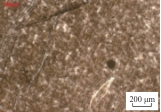 | 以中碳为主,其次为低碳、高碳,局部含碳、富碳 | 以泥质结构为主,少许粉砂碎屑星点分布。黏土矿物为隐晶状、显微鳞片状,部分呈拉长状,其长轴具定向分布。有机质呈斑点状、短细条状分散分布。主要发育于复兴地区东岳庙段,元坝及复兴地区大安寨段 |
| 纹层-薄层状介壳灰质页岩岩相 |  | 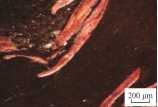 | 以中碳为主、 其次为高碳 | 发育介壳纹层与薄层,镜下仍以泥质结构为主,隐晶状黏土矿物与有机质相混,岩心上可见介壳呈层状定向排列富集。主要发育于复兴地区东岳庙段,元坝、阆中及复兴地区大安寨段 |
| (纹层状)粉砂质页岩岩相 |  | 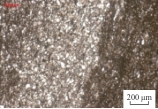 | 以含碳、低碳为主,局部中碳、高碳 | 岩心上可见粉砂质纹层,镜下粉砂泥质结构,粉砂碎屑与隐晶状黏土矿物相混,粉砂碎屑以石英为主,次棱-次圆状,有机质呈斑点状、弯曲拉长状分散分布。主要发育于元坝地区东岳庙段、大安寨段与千佛崖组、复兴地区凉高山组 |
| 混合质页岩岩相 | 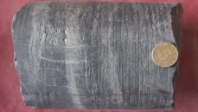 | 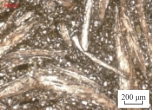 | 以低碳、中碳为主,局部高碳 | 发育泥质结构和粒屑结构,主要由隐晶状黏土矿物、介壳及粉砂碎屑组成,介壳由方解石颗粒组成,有重结晶现象。主要发育于复兴地区东岳庙段底部、复兴及元坝地区大安寨段局部层段 |
| 介壳灰岩岩相 | 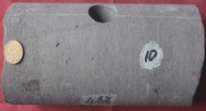 | 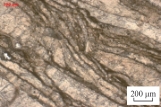 | 低碳 | 发育粒屑结构和晶粒结构,主要由隐晶状黏土矿物、介壳组成,隐晶黏土矿物呈弯曲隙状、团粒状分布于粒间,多相混黑色有机质,介壳由纤柱状方解石组成,少许粒内具硅化作用。主要发育于复兴地区东岳庙段,复兴、阆中及元坝地区大安寨段 |
| 粉砂岩岩相 |  | 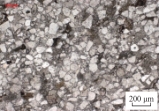 | 低碳 | 发育粉砂结构,主要由石英组成,含少许长石和岩屑。石英颗粒可见不规则溶蚀边;长石可见双晶,部分颗粒具碳酸盐化;粒间主要是隐晶质黏土矿物,分布不均匀。主要发育于元坝地区东岳庙段、复兴凉高山组及元坝千佛崖组 |
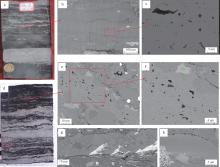
图9
四川盆地侏罗系典型小尺度岩相组合中纹层状介壳方解石粒内及粒缘孔缝发育特征a.介壳灰质页岩,FY10井,东岳庙段,埋深2 787.71 m,岩心照片;b.介壳内溶蚀孔,为a图中红框内样品氩离子抛光扫描电镜照片;c.介壳内溶蚀孔,孔内充填暗色有机质,为b图中红框放大照片;d.介壳灰质页岩,YY2井,大安寨段,埋深3 890.22 m,岩心照片,图中的3 cm为介壳层厚度;e.方解石介壳粒内孔,为d图中红框内样品氩离子抛光扫描电镜照片;f.介壳内溶蚀孔,孔内充填暗色有机质,为e图中红框放大照片;g.方解石介壳内微裂缝,FY1井,东岳庙段,TOC=0.92 %,埋深2 731.41 m,氩离子抛光扫描电镜照片;h.方解石介壳边缘缝,充填暗色有机质,YL4井,大安寨段,TOC=1.23 %,埋深3 748.23 m,氩离子抛光扫描电镜照片"

| 1 | 邹才能, 马锋, 潘松圻, 等. 全球页岩油形成分布潜力及中国陆相页岩油理论技术进展[J]. 地学前缘, 2023, 30(1): 128-142. |
| ZOU Caineng, MA Feng, PAN Songqi, et al. Formation and distribution potential of global shale oil and the developments of continental shale oil theory and technology in China[J]. Earth Science Frontiers, 2023, 30(1): 128-142. | |
| 2 | 金之钧, 白振瑞, 高波, 等. 中国迎来页岩油气革命了吗?[J]. 石油与天然气地质, 2019, 40(3): 451-458. |
| JIN Zhijun, BAI Zhenrui, GAO Bo, et al. Has China ushered in the shale oil and gas revolution?[J]. Oil & Gas Geology, 2019, 40(3): 451-458. | |
| 3 | 唐令, 宋岩, 陈晓智, 等. 页岩气选区评价关键参数及上下限——以四川盆地五峰组—龙马溪组为例[J]. 天然气地球科学, 2023, 34(1): 153-168. |
| TANG Ling, SONG Yan, CHEN Xiaozhi, et al. Key parameters and the upper-lower limits of shale gas selection evaluation: Case study from the Wufeng-Longmaxi formations in the Sichuan Basin[J]. Natural Gas Geoscience, 2023, 34(1): 153-168. | |
| 4 | 唐令, 宋岩, 赵志刚, 等. 四川盆地上奥陶统五峰组—下志留统龙马溪组页岩气藏超压成因及演化规律[J]. 天然气工业, 2022, 42(10): 37-53. |
| TANG Ling, SONG Yan, ZHAO Zhigang, et al. Origin and evolution of overpressure in shale gas reservoirs of the Upper Ordovician Wufeng Formation-Lower Silurian Longmaxi Formation in the Sichuan Basin[J]. Natural Gas Industry, 2022, 42(10): 37-53. | |
| 5 | 武瑾, 李玮, 刘鑫, 等. 四川盆地海相页岩气碳同位素特征及指示意义[J]. 特种油气藏, 2022, 29(5): 36-41. |
| WU Jin, LI Wei, LIU Xin, et al. Characteristics and indicative significance of carbon isotopes of marine shale gas in Sichuan Basin[J]. Special Oil & Gas Reservoirs, 2022, 29(5): 36-41. | |
| 6 | TANG Ling, WANG Pengfei, ZHAO Zhigang, et al. Overpressure origin and evolution during burial in the shale gas plays of the Wufeng-Longmaxi formations of southern Sichuan Basin[J]. Geoenergy Science and Engineering, 2024, 236: 212729. |
| 7 | 马永生, 蔡勋育, 赵培荣, 等. 中国陆相页岩油地质特征与勘探实践[J]. 地质学报, 2022, 96(1): 155-171. |
| MA Yongsheng, CAI Xunyu, ZHAO Peirong, et al. Geological characteristics and exploration practices of continental shale oil in China[J]. Acta Geologica Sinica, 2022, 96(1): 155-171. | |
| 8 | 高波, 武晓玲, 张英, 等. 鄂尔多斯盆地南部张家滩油页岩生烃演化特征[J]. 石油实验地质, 2022, 44(1): 24-32. |
| GAO Bo, WU Xiaoling, ZHANG Ying, et al. Hydrocarbon generation and evolution characteristics of Triassic Zhangjiatan oil shale in southern Ordos Basin[J]. Petroleum Geology and Experiment, 2022, 44(1): 24-32. | |
| 9 | 马存飞, 孙文静, 曾令鹏, 等. 沧东凹陷孔二段页岩中基于岩心裂缝观测的构造裂缝规模解析[J]. 中国石油大学学报(自然科学版), 2023, 47(4): 1-11. |
| MA Cunfei, SUN Wenjing, ZENG Lingpeng, et al. Mathematical analysis of structural fracture scale in shale based on core fracture observation of the second member of Kongdian Formation in Cangdong Sag[J]. Journal of China University of Petroleum (Edition of Natural Science), 2023, 47(4): 1-11. | |
| 10 | 王小军, 宋永, 郭旭光, 等. 陆相咸化湖盆细粒沉积岩分类及其石油地质意义[J]. 沉积学报, 2023, 41(1): 303-317. |
| WANG Xiaojun, SONG Yong, GUO Xuguang, et al. Classification of fine-grained sedimentary rocks in saline lacustrine basins and its petroleum geological significance[J]. Acta Sedimentologica Sinica, 2023, 41(1): 303-317. | |
| 11 | 胡宗全, 王濡岳, 刘忠宝, 等. 四川盆地下侏罗统陆相页岩气源储特征及耦合评价[J]. 地学前缘, 2021, 28(1): 261-272. |
| HU Zongquan, WANG Ruyue, LIU Zhongbao, et al. Source-reservoir characteristics and coupling evaluations for the Lower Jurassic lacustrine shale gas reservoir in the Sichuan Basin[J]. Earth Science Frontiers, 2021, 28(1): 261-272. | |
| 12 | 焦方正, 邹才能, 杨智. 陆相源内石油聚集地质理论认识及勘探开发实践[J]. 石油勘探与开发, 2020, 47(6): 1067-1078. |
| JIAO Fangzheng, ZOU Caineng, YANG Zhi. Geological theory and exploration & development practice of hydrocarbon accumulation inside continental source kitchens[J]. Petroleum Exploration and Development, 2020, 47(6): 1067-1078. | |
| 13 | 邹才能, 杨智, 董大忠, 等. 非常规源岩层系油气形成分布与前景展望[J]. 地球科学, 2022, 47(5): 1517-1533. |
| ZOU Caineng, YANG Zhi, DONG Dazhong, et al. Formation, distribution and prospect of unconventional hydrocarbons in source rock strata in China[J]. Earth Science, 2022, 47(5): 1517-1533. | |
| 14 | 王小军, 宋永, 郭旭光, 等. 陆相咸化湖盆细粒沉积岩分类及其石油地质意义[J]. 沉积学报, 2023, 41(1): 303-317. |
| WANG Xiaojun, SONG Yong, GUO Xuguang, et al. Classification of fine-grained sedimentary rocks in saline lacustrine basins and its petroleum geological significance[J]. Acta Sedimentologica Sinica, 2023, 41(1): 303-317. | |
| 15 | 张顺, 刘惠民, 陈世悦, 等. 中国东部断陷湖盆细粒沉积岩岩相划分方案探讨——以渤海湾盆地南部古近系细粒沉积岩为例[J]. 地质学报, 2017, 91(5): 1108-1119. |
| ZHANG Shun, LIU Huimin, CHEN Shiyue, et al. Classification scheme for lithofacies of fine-grained sedimentary rocks in faulted basins of eastern China: Insights from the fine-grained sedimentary rocks in Paleogene, southern Bohai Bay Basin[J]. Acta Geologica Sinica, 2017, 91(5): 1108-1119. | |
| 16 | 柳波, 石佳欣, 付晓飞, 等. 陆相泥页岩层系岩相特征与页岩油富集条件——以松辽盆地古龙凹陷白垩系青山口组一段富有机质泥页岩为例[J]. 石油勘探与开发, 2018, 45(5): 828-838. |
| LIU Bo, SHI Jiaxin, FU Xiaofei, et al. Petrological characteristics and shale oil enrichment of lacustrine fine-grained sedimentary system: A case study of organic-rich shale in first member of Cretaceous Qingshankou Formation in Gulong Sag, Songliao Basin, NE China[J]. Petroleum Exploration and Development, 2018, 45(5): 828-838. | |
| 17 | 刘惠民, 王勇, 杨永红, 等. 东营凹陷细粒混积岩发育环境及其岩相组合:以沙四上亚段泥页岩细粒沉积为例[J]. 地球科学, 2020, 45(10): 3543-3555. |
| LIU Huimin, WANG Yong, YANG Yonghong, et al. Sedimentary environment and lithofacies of fine-grained hybrid sedimentary in Dongying Sag: A case of fine-grained sedimentary system of the Es4 [J]. Earth Science, 2020, 45(10): 3543-3555. | |
| 18 | 易娟子, 张少敏, 蔡来星, 等. 川东地区下侏罗统凉高山组地层-沉积充填特征与油气勘探方向[J]. 吉林大学学报(地球科学版), 2022, 52(3): 795-815. |
| YI Juanzi, ZHANG Shaomin, CAI Laixing, et al. Strata and sedimentary filling characteristics of the Lower Jurassic Lianggaoshan Formation and its hydrocarbon exploration in eastern Sichuan Basin[J]. Journal of Jilin University(Earth Science Edition), 2022, 52(3): 795-815. | |
| 19 | 杨帅. 四川盆地侏罗系沉积演化与相控储层预测[D]. 成都: 成都理工大学, 2014. |
| YANG Shuai. Sedimentary evolution during Jurassic and faces-controlling reservoir prediction in Sichuan Basin, China[D]. Chengdu: Chengdu University of Technology, 2014. | |
| 20 | LI Qianwen, LIU Zhongbao, CHEN Feiran, et al. Behavior and controlling factors of methane adsorption in Jurassic continental shale, northeastern Sichuan Basin[J]. Energy Geoscience, 2023, 4(1): 83-92. |
| 21 | 舒志国, 周林, 李雄, 等. 四川盆地东部复兴地区侏罗系自流井组东岳庙段陆相页岩凝析气藏地质特征及勘探开发前景[J]. 石油与天然气地质, 2021, 42(1): 212-223. |
| SHU Zhiguo, ZHOU Lin, LI Xiong, et al. Geological characteristics of gas condensate reservoirs and their exploration and development prospect in the Jurassic continental shale of the Dongyuemiao Member of Ziliujing Formation, Fuxing area, eastern Sichuan Basin[J]. Oil & Gas Geology, 2021, 42(1): 212-223. | |
| 22 | 李楚楚, 洪秀娥, 韩登林, 等. 湖相混积岩有利储层岩性测井识别方法——以大王庄油田沙三上亚段为例[J]. 石油地质与工程, 2023, 37(4): 37-44. |
| LI Chuchu, HONG Xiue, HAN Denglin, et al. Identification method of lithology by logging in favorable reservoir of lacustrine mixed rock——A case study of the small layer 2 of the upper part of the member 3 of Shahejie Formation in Dawangzhuang Oilfield[J]. Petroleum Geology & Engineering, 2023, 37(4): 37-44. | |
| 23 | 胡东风, 魏志红, 刘若冰, 等. 四川盆地拔山寺向斜泰页1井页岩油气重大突破及意义[J]. 中国石油勘探, 2021, 26(2): 21-32. |
| HU Dongfeng, WEI Zhihong, LIU Ruobing, et al. Major breakthrough of shale oil and gas in Well Taiye 1 in Bashansi syncline in the Sichuan Basin and its significance[J]. China Petroleum Exploration, 2021, 26(2): 21-32. | |
| 24 | 徐田武, 张成富, 李红磊, 等. 不同环境下陆相页岩油气富集关键要素下限研究——以中原油田探区为例[J]. 断块油气田, 2022, 29(6): 721-728, 743. |
| XU Tianwu, ZHANG Chengfu, LI Honglei, et al. Research on lower limits of key factor controlling hydrocarbon accumulation of continental shale in different environments: taking exploratory area of Zhongyuan Oilfield as an example[J]. Fault-Block Oil and Gas Field, 2022, 29(6): 721-728, 743. | |
| 25 | 郭旭升, 赵永强, 张文涛, 等. 四川盆地元坝地区千佛崖组页岩油气富集特征与主控因素[J]. 石油实验地质, 2021, 43(5): 749-757. |
| GUO Xusheng, ZHAO Yongqiang, ZHANG Wentao, et al. Accumulation conditions and controlling factors for the enrichment of shale oil and gas in the Jurassic Qianfoya Formation, Yuanba area, Sichuan Basin[J]. Petroleum Geology and Experiment, 2021, 43(5): 749-757. | |
| 26 | 曾花森, 霍秋立, 张晓畅, 等. 松辽盆地古龙页岩油赋存状态演化定量研究[J]. 大庆石油地质与开发, 2022, 41(3): 80-90. |
| ZENG Huasen, HUO Qiuli, ZHANG Xiaochang, et al. Quantitative analysis on occurrence evolution of Gulong shale oil in Songliao Basin[J]. Petroleum Geology & Oilfield Development in Daqing, 2022, 41(3): 80-90. | |
| 27 | 何文渊, 何海清, 王玉华, 等. 川东北地区平安1井侏罗系凉高山组页岩油重大突破及意义[J]. 中国石油勘探, 2022, 27(1): 40-49. |
| HE Wenyuan, HE Haiqing, WANG Yuhua, et al. Major breakthrough and significance of shale oil of the Jurassic Lianggaoshan Formation in Well Ping’an 1 in northeastern Sichuan Basin[J]. China Petroleum Exploration, 2022, 27(1): 40-49. | |
| 28 | 彭军, 曾垚, 杨一茗, 等. 细粒沉积岩岩石分类及命名方案探讨[J]. 石油勘探与开发, 2022, 49(1): 106-115. |
| PENG Jun, ZENG Yao, YANG Yiming, et al. Discussion on classification and naming scheme of fine-grained sedimentary rocks[J]. Petroleum Exploration and Development, 2022, 49(1): 106-115. | |
| 29 | 郭旭升, 魏志红, 魏祥峰, 等. 四川盆地侏罗系陆相页岩油气富集条件及勘探方向[J]. 石油学报, 2023, 44(1): 14-27. |
| GUO Xusheng, WEI Zhihong, WEI Xiangfeng, et al. Enrichment conditions and exploration direction of Jurassic continental shale oil and gas in Sichuan Basin[J]. Acta Petrolei Sinica, 2023, 44(1): 14-27. | |
| 30 | 刘雨林, 范凌霄, 房大志, 等. 源—储分类新方法在川东地区页岩气井产量分析中的应用[J]. 油气藏评价与开发, 2022, 12(3): 429-436. |
| LIU Yulin, FAN Lingxiao, FANG Dazhi, et al. Application of a new source-reservoir classification method in production analysis of shale gas wells in Eastern Sichuan[J]. Petroleum Reservoir Evaluation and Development, 2022, 12(3): 429-436. |
| [1] | 李一波, 陈耀旺, 赵金洲, 王志强, 魏兵, Valeriy Kadet. 超临界二氧化碳与页岩相互作用机制[J]. 石油与天然气地质, 2024, 45(4): 1180-1194. |
| [2] | 叶玥豪, 陈伟, 汪华, 宋金民, 明盈, 戴鑫, 李智武, 孙豪飞, 马小刚, 刘婷婷, 唐辉, 刘树根. 四川盆地上二叠统大隆组页岩储层特征及其控制因素[J]. 石油与天然气地质, 2024, 45(4): 979-991. |
| [3] | 方锐, 蒋裕强, 杨长城, 邓海波, 蒋婵, 洪海涛, 唐松, 谷一凡, 朱讯, 孙莎莎, 蔡光银. 四川盆地侏罗系凉高山组不同岩性组合页岩油赋存状态及可动性[J]. 石油与天然气地质, 2024, 45(3): 752-769. |
| [4] | 何骁, 郑马嘉, 刘勇, 赵群, 石学文, 姜振学, 吴伟, 伍亚, 宁诗坦, 唐相路, 刘达东. 四川盆地“槽-隆”控制下的寒武系筇竹寺组页岩储层特征及其差异性成因[J]. 石油与天然气地质, 2024, 45(2): 420-439. |
| [5] | 张赫驿, 杨帅, 张玺华, 彭瀚霖, 李乾, 陈聪, 高兆龙, 陈安清. 川东地区中二叠统茅口组沉积微相与环境演变[J]. 石油与天然气地质, 2024, 45(2): 457-470. |
| [6] | 潘辉, 蒋裕强, 朱讯, 邓海波, 宋林珂, 王占磊, 李杪, 周亚东, 冯林杰, 袁永亮, 王猛. 河流相致密砂岩气地质甜点评价[J]. 石油与天然气地质, 2024, 45(2): 471-485. |
| [7] | 张宝收, 张本健, 汪华, 陈践发, 刘凯旋, 豆霜, 戴鑫, 陈双玲. 四川盆地金秋气田:一个典型以中生界沉积岩为氦源岩的含氦-富氦气田[J]. 石油与天然气地质, 2024, 45(1): 185-199. |
| [8] | 张自力, 乔艳萍, 豆霜, 李堃宇, 钟原, 武鲁亚, 张宝收, 戴鑫, 金鑫, 王斌, 宋金民. 四川盆地蓬莱气区震旦系灯影组二段岩溶古地貌与控储模式[J]. 石油与天然气地质, 2024, 45(1): 200-214. |
| [9] | 郭旭升, 马晓潇, 黎茂稳, 钱门辉, 胡宗全. 陆相页岩油富集机理探讨[J]. 石油与天然气地质, 2023, 44(6): 1333-1349. |
| [10] | 王光付, 李凤霞, 王海波, 周彤, 张亚雄, 王濡岳, 李宁, 陈昱辛, 熊晓菲. 四川盆地不同类型页岩气压裂难点和对策[J]. 石油与天然气地质, 2023, 44(6): 1378-1392. |
| [11] | 胡宗全, 王濡岳, 路菁, 冯动军, 刘粤蛟, 申宝剑, 刘忠宝, 王冠平, 何建华. 陆相页岩及其夹层储集特征对比与差异演化模式[J]. 石油与天然气地质, 2023, 44(6): 1393-1404. |
| [12] | 王红岩, 周尚文, 赵群, 施振生, 刘德勋, 焦鹏飞. 川南地区深层页岩气富集特征、勘探开发进展及展望[J]. 石油与天然气地质, 2023, 44(6): 1430-1441. |
| [13] | 边瑞康, 孙川翔, 聂海宽, 刘珠江, 杜伟, 李沛, 王濡岳. 四川盆地东南部五峰组-龙马溪组深层页岩气藏类型、特征及勘探方向[J]. 石油与天然气地质, 2023, 44(6): 1515-1529. |
| [14] | 李双建, 李智, 张磊, 李英强, 孟宪武, 王海军. 四川盆地川西坳陷三叠系盐下超深层油气成藏条件与勘探方向[J]. 石油与天然气地质, 2023, 44(6): 1555-1567. |
| [15] | 曾溅辉, 张亚雄, 张在振, 乔俊程, 王茂云, 陈冬霞, 姚泾利, 丁景辰, 熊亮, 刘亚洲, 赵伟波, 任克博. 致密砂岩气藏复杂气-水关系形成和分布主控因素及分布模式[J]. 石油与天然气地质, 2023, 44(5): 1067-1083. |
| 阅读次数 | ||||||
|
全文 |
|
|||||
|
摘要 |
|
|||||